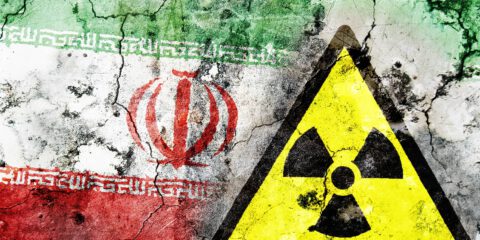כשתוכנית החלל של ארגון משמרות המהפכה ודבר שליטתו על מרכז פיתוח ושיגור משלו נחשפו לעולם הרחב, סביר להניח שטילי הענק שהוא מפתח במעמקי המדבריות של צפון-מזרח איראן יופיעו על משטח השיגור עצום הממדים בשאהרוד בעתיד הלא רחוק.
בעוד שמרבית תשומת הלב במערב נתונה לתוכנית הטילים המרשימה של איראן, תוכנית החלל שלה זוכה להרבה פחות התעניינות, ושלא בצדק: תוכנית החלל האיראנית הינה אחד מעמודי התווך של תוכנית הטילים של הרפובליקה האסלאמית. מנהיגי איראן הכריזו פעמים מספר על מגבלה מרצון שהטילו על טווח הטילים הבליסטיים וטילי השיוט שלהם: לא יותר מ-2,000 ק”מ. לא היה ב”התנדבות” זו שום אות של רצון טוב. טווח של 2,000 ק”מ מאפשר לאיראן לאיים על כל מדינה שתחפוץ במזרח התיכון, אך איננו מאיים על מדינות מערב אירופה. הנכונות הנדיבה כביכול מצד האייטולות להימנע מלהצטייד בטילים שמאיימים על מערב אירופה מסייעת לשכנע פוליטיקאים, פרשנים ופעילי שלום באירופה ברצונה הטוב של הרפובליקה האסלאמית, ובעיקר להעניק להם תחושת רווחה על כך שהם אינם על הכוונת האיראנית. תחושת רווחה זו מסייעת למנוע סנקציות אירופיות על איראן ולשמר את קשרי הסחר עם אירופה, שכה חיוניים לכלכלתה. לאמיתו של דבר, החזון של האייתולות של איראן הינו חובק עולם: להפוך ממעצמה אזורית למעצמה גלובלית. תוכנית החלל הינה רכיב חיוני בדרך למימוש חזון זה. כדבריו של סגן מפקד חיל האוויר והחלל של משמרות המהפכה, הגנרל מאג’יד מוסאבי בריאיון משנת 2014: “תפקידה של תוכנית החלל הוא בעיקר לקדם טכנולוגיות בכסות של תוכנית חלל אזרחית, ובמיוחד כדי לעקוף את המגבלה העצמית של 2,000 ק”מ”.
הגנרל מוסאבי אמר את דבריו אלה בפרסית, לא באנגלית. כשהדברים נאמרים באנגלית, לתוכנית החלל של איראן אין שום קשר לצבא ולביטחון, היא נועדה כל כולה להיות תוכנית אזרחית לצורך ניצול החלל לטובת האנושות. איראן ייסדה את תוכנית החלל האזרחית שלה בשנת 2004, עם הקמתה של סוכנות החלל האיראנית (סח”א) בכפיפות למשרד התקשורת של ממשלת איראן. מיקומה הנמוך של סח”א בהיררכיה הממשלתית תאם את רמת התקצוב הנמוכה שלה, ובאופן בלתי נמנע הביאה לתוצאות פחות ממשביעות רצון. הדור הראשון של משגרי חלל שפותח בחסות סח”א היה ה”סאפיר”, משגר לוויינים קל ששלבו הראשון היה הטיל הבליסטי הוותיק והאמין “שאהאב 3”, במקור הטיל הצפון-קוריאני “נו דונג”, שהוא עצמו היה פרי פיתוח רוסי. השלב השני היה מבוסס על מנועים נוזליים שהועתקו מהטיל הבליסטי הצפון-קוריאני “מוסודאן” – אף הוא ממוצא רוסי – שנרכש על ידי איראן וקיבל אצלה את השם “חוראמשאר”. השיגור הראשון של ה”סאפיר” היה באוגוסט 2008 והסתיים בכישלון. מאידך, השיגור השני בפברואר 2009 הצליח להכניס לוויין ניסיוני למסלול נמוך סביב כדור הארץ. במשך השנים נערכו שיגורים נוספים, אך המידע לגבי מספרם ותוצאותיהם איננו ברור. ככלל, איראן איננה ששה להודות בכישלונות, ובכלל זה בכישלונות בשיגור לוויינים. לפי כמה מקורות בוצעו עד כה 8 שיגורי “סאפיר”, אך לפי מקורות אחרים המספר הנכון הוא 10 שיגורים. בכל מקרה, אין חילוקי דעות על כך שמתוך שיגורים אלה רק ארבעה (כולל זה של פברואר 2009) הצליחו להכניס לוויין למסלול.
בשנת 2010 חשפה איראן את הדור השני של משגרי הלוויינים שלה: המשגר “סימורג”, שהיה גדול בהרבה מה”סאפיר” ושהיו לו קווי דמיון למשגר הלוויינים הצפון-קוריאני “אונהה”. ה”סימורג” שוגר לראשונה ב-2015 לניסוי תת-מסלולי (דהיינו, למסלול שלא נועד להציב לוויין בחלל). מאז בוצעו שלושה ניסיונות לשגר לוויין בעזרת ה”סימורג”, וכולם כשלו. בסך הכול ביצעה איראן עד תחילת אפריל 2020 11 או 13 שיגורי חלל מאז השיגור הראשון בקיץ 2004, ומתוכם רק ארבעה צלחו. זוהי תוצאה בלתי מרשימה, בלשון המעטה. אומנם גם הצלחה חלקית זו הכניסה את איראן למועדון האקסקלוסיבי של מדינות “יורדות חלל” – המדינה התשיעית במספר שהצליחה להגיע למעמד זה – אך הצלחה זו הועמה על ידי כישלונות חוזרים ונשנים ועל ידי עמימות וחוסר שקיפות. כתרגיל הסחה נוסף הוסיפו האיראנים תוכניות משניות של שיגור בעלי חיים (ובכללם גם קופים) לשהיות קצרות בחלל בעזרת שיגורים תת-מסלוליים, ובנוסף פיזרו הצהרות על תוכנית לשיגור אסטרונאוטים איראניים לחלל, תוכנית שפרטיה נשארו מעורפלים ושכנראה נגנזה בקול דממה דקה. מצבה הרופף של תוכנית החלל עורער עוד יותר על ידי שינויים תכופים במעמדה ובשייכותה הארגונית של סח”א. לפי כמה מקורות, נשיא איראן רוחאני ביטל בחשאי את תוכנית החלל כולה בשנת 2015. גם בהינתן שאומנם התוכנית הופסקה הרי שהיא חודשה זמן קצר לאחר מכן, כפי שניתן ללמוד מכך שבשנה שעברה – שנת 2019 – נעשו לא פחות מארבעה ניסיונות לשגר לוויינים לחלל, שכולם הסתיימו בכישלון. הניגוד הבולט בין ביצועים כושלים אלה לדינמיות, לגיוון, ליצירתיות ולהצלחה של תוכניות הטילים הצבאיות מעיד על העדיפות הנמוכה שניתנה לתוכנית החלל במשאבים כספיים ובכוח אדם איכותי. מדוע אם כן התעקשו האייטולות להמשיך בתוכנית זו?
במבט מקרוב, המעטה הדקיק של “תוכנית חלל אזרחית לצורכי שלום לטובת האנושות” לא הצליח להסתיר את אופייה הצבאי של תוכנית החלל האיראנית. האופי הצבאי לא ניכר דווקא מהטכנולוגיות הצבאיות ששימשו לתוכנית “האזרחית”. השימוש בטכנולוגיות וברכיבים צבאיים לתוכניות חלל אזרחיות איננו ייחודי לאיראן, והוא נפוץ בכל שאר מדינות העולם. ברבים ממשגרי הלוויינים המסחריים של ימינו עדיין ניכר מוצאם המקורי מטילים בליסטיים צבאיים. הדבר שחושף יותר מכול את האופי הצבאי של תוכנית החלל האיראנית הוא העדרם של ראשי סח”א מאירועים פומביים בולטים בתוכנית החלל. בכל אירוע ראשי, כמו הצלחה בשיגור לווייני, אנשי הצבא הם אלה שעומדים מול מצלמות הטלוויזיה ומקבלים את הקרדיט. לפקידים ולמדענים שעומדים בראש סח”א המשטר מתיר לעמוד במרכז הבימה רק באירועים משניים, כמו תצוגה של מערכות חלל בפרלמנט האיראני או לאחר שיגורים תת-מסלוליים של בעלי חיים. אחת הדוגמאות הבולטות לכך הייתה טקס ההשקה של שלבי משגר ה”סימורג” הראשון. המציגים באירוע חגיגי זה, שזכה לכיסוי תקשורתי נרחב באיראן, היו נשיא איראן רוחאני ושר ההגנה שלו, בעצמו גנרל במשמרות המהפכה. כשמוסיפים לכך את ההתבטאות הכנה (ואולי הלא כל כך זהירה) של הגנרל מוסאבי שכבר ציטטנו בראשית מאמר זה, מתקבלת תמונה ברורה על אודות מטרתה האמיתית של תוכנית החלל האיראנית: לשמש כתוכנית הונאה על מנת להסתיר את כוונותיה של איראן לפתח טילים בעלי טווח גלובלי ולהעניק לפעילות הזו ארשת של מכובדות ולגיטימיות, תוך ניצול התמימות של פרשנים, מומחים וקובעי יעדים בעלי השקפות ליברליות במערב.
ב-23.4.2020 הופיע משתתף נוסף ורב עוצמה בתוכנית החלל האיראנית: ארגון משמרות המהפכה (משה”מ) בכבודו ובעצמו. בבוקרו של אותו יום הצליחה איראן לשגר לוויין חמישי לחלל במסלול נמוך אך יציב. השוני שבין שיגור זה לשיגורים הקודמים היה בשני דברים עקרוניים: ראשית, האחריות לשיגור הייתה ישירות של משה”מ, ללא סיפור הכיסוי של סח”א. שנית, השיגור בוצע לראשונה מאתר השיגור אפוף המסתורין שליד העיר שאהרוד, ולא מאתר השיגור על שם חומייני שבסמנאן שליד טהרן אשר ממנו נעשו כל השיגורים החלליים של איראן עד עתה. הלוויין, שקיבל את הכינוי “נור 1″, הוגדר רשמית כלוויין הצבאי הראשון של איראן. כך אושר דבר קיומה של תוכנית חלל צבאית איראנית הכפופה ישירות למשה”מ ולא לממשלה האזרחית של הרפובליקה האסלאמית. לרבים מאלה שעוקבים אחרי תוכנית החלל האיראנית לא הייתה בכך כל הפתעה.
ההשערות שלמשה”מ יש תעשיות טילים וחלל משלו במקביל ובתחרות לתעשיות האוויריות של איראן הועלו לראשונה בעקבות התפוצצות מסתורית שאירעה בשנת 2011 במתחם שהוגדר כ”בסיס טילים” של משה”מ בביד-קאנה, הנמצא כ-50 ק”מ מזרחית לטהרן. ההתפוצצות האדירה הרעידה חלונות בטהרן וגרמה למותו של הגנרל חסן מוגאדם, מי שנחשב לאבי תוכנית הטילים האיראנית ולמותם של 16 מבכירי עוזריו. צילומי לוויין הראו שההתפוצצות השמידה למעשה את כל הבסיס. מקורות מחוץ לאיראן טענו שההתפוצצות אירעה כתוצאה מתקלה בתהליך הקשור בייצור הודפים מוצקים. אם מידע זה נכון, אזי המתקן בביד-קאנה לא היה “בסיס טילים” גרידא, אלא מפעל של משה”מ לייצור טילים בדלק מוצק, המהווה למעשה תחרות לקבוצת התעשיות הקרויה “קבוצת התעשיות על שם השאהיד באגראם” (ראשי תיבות באנגלית SBIG), שרשמית הינה הספק היחיד לכוחות הצבאיים של איראן של טילים ורקטות של דלק מוצק . הסיבה לכפל מאמצים בזבזני וזולל משאבים כזה יכולה להיות למשל מאבק פנים-ארגוני בין משה”מ לבין משרד הביטחון האיראני והתעשיות הצבאיות שבאחריותו. אפשרות אחרת היא שפעילות משה”מ בנושא מהווה חלק מתוכנית “שחורה” שהמשטר האיראני מעוניין להסתירה משאר העולם, כמו למשל פיתוח טילים בליסטיים בין-יבשתיים. ההשערה האחרונה קיבלה חיזוק מסוים בשנת 2015 כשדבר קיומו של מתקן הטילים בשאהרוד התפרסם לראשונה בתקשורת המערבית.
שאהרוד (Shahrood) היא עיר הררית, כ-330 ק”מ מזרחית לטהרן. כ-40 ק”מ דרומית-מזרחית לעיר זו נמצא מישור מדברי בעל תוואי קרקע בולט: מכתש גדול שמקורו געשי או מטאורי. צילומים מלוויינים מסחריים מערביים גילו שהאיראנים בנו שם מתחם ענק הכולל מבנים שונים בתוך המכתש ומשטח שיגור בגודל חריג. ממדיו של משטח זה מעוררים השתאות: מדובר במשטח של בטון מזוין בעובי 2 מטר שאורכו 200 מטר ורוחבו 140 מטר. תעלת בטון ענקית שאורכה כ-100 מטר ממוקמת כך שתוכל להפנות למדבר הפתוח את גזי הפליטה של הטילים שישוגרו מהמשטח. צילומי הלוויינים הראו גם מגדל שיגור נייד ענק הממוקם מעל הכניסה לתעלת פינוי הגזים. המשטח ממוקם כך שכיוון השיגור ממנו הינו דרום-מערב, כיוון המאפשר מסדרון בטיחות נוח לשיגורים לעבר האוקיינוס ההודי. הקמת המתקן הענק בשאהרוד התבצעה כמעט במקביל להקמת מרכז השיגור החללי על שם חומייני בשדה הניסוי בסמנאן שליד טהראן. בעוד שאת דבר הקמת מרכז החלל על שם חומייני פרסם המשטר האיראני בתופים ובמחולות, את עצם קיומו של המתקן המקביל בשאהרוד הוא נמנע מלפרסם. ניתן להסיק מכך שהמתקן בשהארוד הוא חלק מאותה תוכנית “שחורה” שנחשפה במקצת עקב ההתפוצצות בביד-קאנה.
צילומי לוויין עדכניים יותר חשפו פעילות משמעותית בתוך המכתש. במהלך הזמן נוספו בקרקעית המכתש מבנים המזכירים עמדות ניסוי של מנועים רקטיים מוצקים. בצילום משנת 2015 נראה ליד אחד המבנים הללו כתם חריכה קרקעי שטיפוסי לניסוי מנוע רקטי מוצק. בשנת 2017 נראה כתם חריכה נוסף ליד עמדת ניסוי סמוכה. ניתן להסיק מכך שהמתקנים שבאתר הזה נועדו לייצר ולבצע ניסויים קרקעיים במנועי דלק מוצק גדולים מאוד. מידותיהן של עמדות הניסוי מלמדות שמדובר במנועים רקטיים בקוטר של כשלושה מטר שמשקלם יכול אולי להגיע ל 50 טון – פי שניים ממשקלו של משגר ה”סאפיר” כולו על שני שלביו. צילומי לוויין חוזרים ונשנים הראו שהמתקן שניזוק בהתפוצצות בביד-קאנה בשנת 2011 ננטש ולא שוקם מעולם. סביר אם כן להניח שהפעילות שהייתה בו הועברה לאתר המדברי המרוחק שליד שאהרוד.
עם זאת, השיגור החללי ב-23 באפריל ממשטח השיגור עצום הממדים בשאהרוד לא היה של רקטת ענק חדשה, אלא של גרסה צבאית של ה”סאפיר” הוותיק. משה”מ כינה את הגרסה הזו בשם “קאסד”. ה”קאסד” קצר במידת מה מה”סאפיר”, אך חולק איתו את אותו שלב ראשון, שהוא למעשה גרסה מוארכת של הטיל הבליסטי “שאהאב 3″. השוני בין שתי התצורות הוא בשלבים העליונים שלהם. ל”סאפיר” יש שלב שני נוזלי שקוטרו זהה לשלב הראשון. מניתוח המידע הצילומי בדוח שפורסם באתר “פסיפס” מאת טל ענבר ויאיר רמתי, מתברר שב”קאסד” מותקנים מעל השלב הראשון שני מנועים מוצקים בעלי קוטר קטן יותר. לדברי מפקד חיל האוויר והחלל של משה”מ, הגנרל אמיר חאגז’יזאדה, אחד מהמנועים הללו שמשמש כשלב שני הוא מנוע דלק מוצק מתקדם ביותר שנקרא “סלמן”, ושהוצג בפברואר האחרון בתערוכת הישגים של תעשיית הטילים האיראנית. לגבי זהותו של מנוע השלב השלישי אין עדיין מידע ברור. למרות הטכנולוגיות המתקדמות יותר והוספת שלב שלישי, לא נראה של”קאסד” החדש יש ביצועים טובים יותר מאלה של ה”סאפיר” הוותיק. כושר ההרמה של ה”סאפיר” למסלול לווייני מוערך בכ-50 ק”ג. סביר שכושר ההרמה של ה”קאסד” נמוך יותר, עקב הצורך להקריב חלק ממשקל הלוויין לטובת השלב השלישי. ללוויינים במשקלים צנועים כאלה יש ערך צבאי מוגבל.
ההבדל המשמעותי יותר בין ה”סאפיר” האזרחי כביכול לבין ה”קאסד” הוא בתהליך השיגור. שני סוגי משגרי החלל האלה נישאים אל משטח השיגור על ידי רכב שיגור שמזקיף אותם בעזרת בוכנות הידראוליות ולאחר מכן משגר אותם מהרכב עצמו. רכב השיגור של שתי התצורות הללו זהה למדי, ומבוסס על המשגר הנייד של הטיל הבליסטי “שאהאב 3″. עם זאת, ה”סאפיר” נזקק לצורך שיגורו גם למגדל שיגור שבעזרתו אפשר להכין את משגר הלוויינים לשיגור. במרכזו של משטח השיגור העגול בסמנאן מעוגן מגדל שיגור פרקי. לאחר ההכנות וההרכבות הסופיות, כשה”סאפיר” המותקן על הרכב מוכן להמריא, מגדל השיגור מורכן לרצפה כדי שלא להפריע להמראה. ההכנות לשיגור נמשכות ימים, אם לא שבועות, ובכל אותה תקופה ישנה נוכחות של כלי רכב רבים על משטח השיגור, הן כדי לתדלק את הטיל, הן כדי לבדוק אותו והן לצורכי בטיחות. פעילות מתמשכת זו מאותתת על שיגור מתקרב ימים ושבועות מראש, ומושכת בכך את תשומת הלב של ארגוני ביון ושל התקשורת העולמית, וכן נחיל של לווייני צילום לפני השיגור ולאחריו. לא ניתן להסתיר כישלונות: כשצילומי הלוויין מראים עקבות חריכה על משטח השיגור הצבוע בצבע כחול עז, סימן הוא שבוצע שיגור. אם לא יוצאת בהקדם הודעה של ממשלת איראן, סימן הוא שהשיגור נכשל. באוגוסט 2019 ספגו האיראנים השפלה משמעותית כאשר הלוויינים שחלפו מעל סמנאן צילמו עדות להתפוצצות רבתי על משטח השיגור, כשהעשן עדיין מיתמר משרידי רכב השיגור ומשגר הלוויינים. פרסום צילומים אלה בתקשורת העולמית (וגם בציוץ של נשיא ארה”ב) אילץ את האיראנים, שלא כדרכם, להודות בכישלון.
מאידך, ובניגוד ל”סאפיר”, ה”קאסד” החדש נורה מרכב השיגור ללא צורך במגדל שיגור וללא צי הרכבים שה”סאפיר” מחייב. סביר להניח שה”קאסד” כולו, על שלביו, והלוויין שמותקן עליו, הורכבו ונבדקו במבנה מרוחק, כל המכלול נסע משם בלילה למשטח השיגור בשאהרוד, הגיע לשם לקראת שחר, הוזקף ושוגר בשעות המוקדמות של הבוקר. סביר להניח שההכנות לשיגור לא נעלמו מעיני זרועות המודיעין במערב: פקיד בכיר אמריקאי מסר כי “רכב השיגור נסע מרחק רב”, ורמז בכך שארה”ב עקבה אחרי ההכנות הללו. עם זאת, תהליך ההכנות המקוצר מנע מהתקשורת העולמית לקבל את האיתותים המקדימים שהיא הייתה רגילה להם. מה שעוד יותר משמעותי בתהליך השיגור של ה”קאסד” הוא העובדה שמעתה משה”מ יהיה מסוגל להכין את שיגורי החלל שלו עמוק בתוך “ערי הטילים” התת-קרקעיות שפיזר ברחבי איראן, להגיח החוצה למשטחי שיגור מאולתרים סמוכים, לשגר בזמן קצר ולסגת מיד חזרה למסתור. משה”מ, כפי הנראה, שואף להשריד את מערך השיגור הלווייני שלו בפני תקיפה מקדימה באותה רמה שהוא משריד את מערך הטילים הבליסטיים שלו.
משה”מ לא פרסם כל מידע על לוויין ה”נור 1″ ששוגר בעזרת ה”קאסד”. עם זאת, חלקו העליון של משגר ה”קאסד” נשא לוגו ענק שהראה לוויין חולף מעל מערב המזרח התיכון. הלוויין שמצויר בלוגו הזה נראה כלוויין קובייה ((Cubesat זעיר בעל מפרשים סולריים קטנים. מקצה הלוויין יוצאת “קרן” הממוקדת על ישראל. הלוגו הזה, ועצם העובדה שמשה”מ אישר להפיץ את צילומו, מהווה למעשה אמירה רשמית שה”נור 1″ הינו לוויין צילום. המזעור הקיצוני של מצלמות בעשור האחרון (חִשבו על המצלמה בסמארטפון שלכם) מאפשר להתקין מצלמה אחת או כמה מצלמות אפילו על לוויין זעיר כמו ה”נור 1″. אם אומנם כך הדבר, הרי שהרזולוציה של הצילומים שיופקו ממצלמות הלוויין תהיה קרוב לוודאי פחותה מהרזולוציות של לווייני צילום מסחריים, כמו אלה שמשמשים ל”גוגל ארץ” (Google Earth). מאידך, הערך התעמולתי של צילומים חלליים של סמלי שלטון בישראל, כמו הכנסת או הכור בדימונה, יהיה ניכר ביותר. לפי בלוג המודיעין הישראלי “אינטליטיים” משה”מ מתעתד לשגר בקרוב לוויין נוסף מאותו סוג בשם “נור 2”. לאחר מכן מתוכנן שיגור של לוויין כבד יותר בשם “נור 3″.
ביצוע שיגור חללי בשעה שאיראן נאבקת במגפת וירוס הקורונה (איראן היא השמינית בסדר המדינות שהמגפה היכתה בהם בעוצמה רבה) מהווה כשלעצמו קריאת תיגר והצהרת נחישות. המסר העיקרי הוא לרחוב האיראני, לאמור שבכל הנוגע לביטחון הלאומי, העסקים כרגיל. ה”קאסד” מהווה במידה רבה תכנון חדש, והלוויין “נור 1″ הינו תכנון חדש לחלוטין. סביר שפיתוחם וניסויי ההוכחה שלהם נמשכו שנים. על כן סביר להניח שמועד השיגור המבצעי הראשון שלהם תוכנן חודשים, אם לא שנים מראש, וכי העובדה שהוא יצא לפועל בעיצומה של מגפת הקורונה היה מקרי.
מאידך, העובדה שהמנהיג העליון של איראן, עלי חמנאי, אישר לשגר את ה”קאסד” בעת צרה זו לאיראן היא משמעותית כשלעצמה. עוד יותר משמעותית מכך היא חשיפתו של משה”מ כאחראי על תוכנית החלל האמיתית של איראן. דבר זה מעיד על כוחו הגובר של משה”מ בחוגי השלטון של איראן, ומבשר מחד הקשחה נוספת של מדיניותה ומאידך החלשה נוספת של הגורמים המתונים (יחסית) בקרב הממשל. עתה, כשתוכנית החלל של משה”מ ודבר שליטתו על מרכז פיתוח ושיגור משלו נחשפו לעולם הרחב, סביר להניח שטילי הענק שהוא מפתח במעמקי המדבריות של צפון-מזרח איראן יופיעו על משטח השיגור עצום הממדים בשאהרוד בעתיד הלא רחוק.
סדרת הפרסומים “ניירות עמדה” מטעם המכון מתפרסמת הודות לנדיבותה של משפחת גרג רוסהנדלר.
תמונה:Freepik










 - בניית אתרים
- בניית אתרים